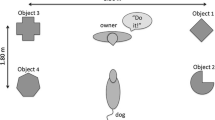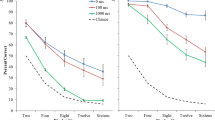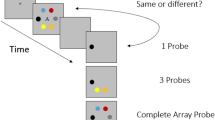Abstract
Two experiments explored the duration of dogs' working memory in an object permanence task: a delay was introduced between the disappearance of a moving object behind a box and the beginning of the search by the animal. In experiment 1, the dogs were tested with retention intervals of 0, 10, 30, and 60 s. Results revealed that the dogs' accuracy declined as a function of the length of the retention interval but remained above chance for each retention interval. In experiment 2, with new subjects, longer retention intervals (0, 30, 60, 120, and 240 s) were presented to the dogs. Results replicated findings from experiment 1 and revealed that the dogs' accuracy remained higher than chance level with delays up to 240 s. In both experiments, the analysis of errors also showed that the dogs searched as a function of the proximity of the target box and were not subject to intertrial proactive interference. In the discussion, we explore different alternatives to explain why dogs' search behaviour for hidden objects decreased as a function of the retention intervals.


Similar content being viewed by others
References
American Kennel Club (1992) The complete dog book, 18th edn. Howell Book House, New York
Balda RP, Kamil AC (1998) The ecology and evolution of spatial memory in corvids of the southwestern USA: the perplexing pinyon jay. In Balda RP, Pepperberg IM, Kamil AC (eds) Animal cognition in nature: the convergence of psychology and biology in laboratory and field. Academic Press, Toronto, pp 29–64
Bjork EL, Cummings EM (1984) Infant search errors: stage of concept development or stage of memory development. Mem Cogn 12:1–19
Call J (2001) Object permanence in orangutans (Pongo pygmaeus), chimpanzees (Pan troglodytes), and children (Homo sapiens). J Comp Psychol 115:159–171
Chan ADF, Nippak PMD, Murphey H, Ikeda-Douglas CJ, Muggenburg B, Head E, Cotman CW, Milgram NW (2002) Visuospatial impairments in aged canines (Canis familiaris): the role of cognitive-behavioral flexibility. Behav Neurosci 116:443–454
De Blois ST, Novak MA (1994) Object permanence in rhesus monkeys (Macaca mulatta). J Comp Psychol 108:318–327
De Blois ST, Novak MA, Bond M (1998) Object permanence in orangutans (Pongo pygmaeus) and squirrel monkeys (Saimiri sciurus). J Comp Psychol 112:137–152
De Blois ST, Novak MA, Bond M (1999) Can memory requirements account for species' differences in invisible displacement tasks? J Exp Psychol Anim Behav 25:168–176
Doré FY (1986) Object permanence in adult cats (Felis catus). J Comp Psychol 100:340–347
Doré FY (1990) Search behavior of cats (Felis catus) in an invisible displacement test: cognition and experience. Can J Psychol 44:359–370
Doré FY, Dumas C (1987) Psychology of animal cognition: Piagetian studies. Psychol Bull 102:219–233
Doré FY, Goulet S (1998) The comparative analysis of object knowledge. In: Langer J, Killen M (eds) Piaget, evolution, and development. Erlbaum, Mahwah, N.J., pp 55–72
Doré FY, Fiset S, Goulet S, Dumas M-C, Gagnon S (1996) Search behavior in cats and dogs: interspecific differences in working memory and spatial cognition. Anim Learn Behav 24:142–149
Dumas C, Doré FY (1989) Cognitive development of kittens: a cross-sectional study of object permanence. J Comp Psychol 103:191–200
Dumas C, Doré FY (1991) Cognitive development in kittens (Felis catus): an observational study of object permanence and sensorimotor intelligence. J Comp Psychol 105:357–365
Edhouse WV, White KG (1988) Sources of proactive interference in animal memory. J Exp Psychol Anim Behav 14:56–70
Étienne AS (1973) Developmental stages and cognitive structures as determinants of what is learned. In: Hinde RA, Stevenson-Hinde J (eds) Constraints on learning: limitations and predispositions. Academic Press, New York, pp 317–395
Étienne AS (1984) The meaning of object concept at different zoological levels. Hum Dev 27:309–320
Fiset S, Doré FY (1996) Spatial encoding in domestic cats (Felis catus). J Exp Psychol Anim Behav 22:420–437
Fiset S, Gagnon S, Beaulieu C (2000) Spatial encoding of hidden objects in dogs (Canis familiaris). J Comp Psychol 114:315–324
Fletcher HJ (1965) The delayed response problem. In: Schrier AM, Harlow HF, Stollnitz F (eds) Behavior of nonhuman primates, vol 1. Academic Press, New York, pp 129–165
Funk MS (1996) Development of object permanence in the New Zealand parakeet (Cyanoramphus auriceps). Anim Learn Behav 24:375–384
Gagnon S, Doré FY (1992) Search behavior in various breeds of adult dogs (Canis familiaris): object permanence and olfactory cues. J Comp Psychol 106:58–68
Gagnon S, Doré FY (1993) Search behavior of dogs (Canis familiaris) in invisible displacement problems. Anim Learn Behav 21:246–254
Gagnon S, Doré FY (1994) Cross-sectional study of object permanence in domestic puppies (Canis familiaris). J Comp Psychol 108:220–232
Goulet S, Doré FY, Rousseau R (1994) Object permanence and working memory in cats (Felis catus). J Exp Psychol Anim Behav 20:347–365
Goulet S, Doré FY, Lehotkay R (1996) Activation of locations in working memory in cats. Q J Exp Psychol B 49:81–92
Grant DS (1981) Intertrial interference in rat short-term memory. J Exp Psychol Anim Behav 7:217–227
Gruber HE, Girgus JS, Banuazizi A (1971) The development of object permanence in the cat. Dev Psychol 4:9–15
Hampton RR, Shettleworth SJ, Westwood RP (1998) Proactive interference, recency, and associative strength: comparisons of black-capped chickadees and dark-eyes juncos. Anim Learn Behav 26:475–485
Head E, Mehta R, Hartley J, Kameka M, Cummings BJ, Cotman CW, Ruehl WW, Milgram NW (1995) Spatial learning and memory as a function of age in the dog. Behav Neurosci 109:851–858
Hunter WS (1913) The delayed reaction in animals and children. Behav Monogr 2(6)
Kowalska DM (1995) Effects of hippocampal lesions on spatial delayed responses in dog. Hippocampus 5:363–370
Kowalska DM (2000) Cognitive functions of the temporal lobe in the dog: a review. Prog Neuropsychopharmacol Biol Psychiatry 24:855–880
Mathieu M, Bouchard MA, Granger L, Herscovitch J (1976) Piagetian object permanence in Cebus capucinus, Lagothrica flavicauda and Pan troglodytes. Anim Behav 24:585–588
Milgram NW, Head E, Weiner E, Thomas E (1994) Cognitive functions and aging in the dog: acquisition of nonspatial visual tasks. Behav Neurosci 108:57–68
Milgram NW, Adams B, Callahan H, Head E, Mackay B, Thirlwell C, Cotman CW (1999) Landmark discrimination learning in the dog. Learn Mem 6:54–61
Natale F, Antinucci F, Spinozzi G, Poti P (1986) Stage 6 object concept in nonhuman primate cognition: a comparison between gorilla (Gorilla gorilla gorilla) and Japanese macaque (Macaca fuscata). J Comp Psychol 100:335–339
Parker ST (1977) Piaget's sensorimotor series in an infant macaque: a model for comparative unstereotyped behavior and intelligence in human and nonhuman primates. In: Chevalier-Skolnikoff S, Poirier FE (eds) Primate bio-social development: biological, social, and ecological determinants. Garland, New York, pp 43–112
Pepperberg IM (2002) The value of the Piagetian framework for comparative cognitive studies. Anim Cogn 5:177–182
Pepperberg IM, Funk MS (1990) Object permanence in four species of psittacine birds: an African grey parrot (Psittacus erithacus), an Illiger mini macaw (Ara Maracana), a parakeet (Melopsittacus undulatus), and a cockatiel (Nymphicus hollandicus). Anim Learn Behav 18:97–108
Pepperberg IM, Kozak FA (1986) Object permanence in the African grey parrot (Psittacus erithacus). Anim Learn Behav 14:322–330
Piaget J (1967) La construction du réel chez l'enfant. (The construction of reality in the child) Delachaux et Niestlé, Neufchâtel, Switzerland (Original work published 1937)
Redshaw M (1978) Cognitive development in human and gorilla infants. J Hum Evol 7:133–141
Roberts WA (1980) Distribution of trials and intertrial retention in delayed matching to sample with pigeons. J Exp Psychol Anim Behav 6:217–237
Siegal S, Castellan NJ (1988) Nonparametric statistics for behavioral sciences, 2nd edn. McGraw-Hill, New York
Thinus-Blanc C, Poucet B, Chapuis N (1982) Object permanence in cats: analysis in locomotor space. Behav Process 7:81–87
Triana E, Pasnak R (1981) Object permanence in cats and dogs. Anim Learn Behav 9:135–139
Yarbrough JU (1917) The delayed reaction with sound and light in cats. J Anim Behav 7:87–110
Vallortigara G, Regolin L, Rigoni M, Zanforlin M (1998) Delayed search for a concealed imprinted object in the domestic chick. Anim Cogn 1:17–24
Walton AC (1915) The influence of diverting stimuli during delayed reaction in dogs. J Anim Behav 5:259–291
Wood S, Moriarty KM, Gardner BT, Gardner RA (1980) Object permanence in child and chimpanzee. Anim Learn Behav 8:3–9
Acknowledgements
This research was supported by an operating research grant from the Natural Sciences and Engineering Research Council of Canada (NSERC) and by a research grant from the Faculté des Études Supérieures et de la Recherche (FESR) of Université de Moncton. The experiments received approval from the Comité de protection des animaux from the Faculté des études supérieures et de la recherche de l'Université de Moncton, which is responsible for the application and enforcement of rules of the Canadian Council on Animal Care. We thank the dogs' owners who participated in these experiments.
Author information
Authors and Affiliations
Corresponding author
Rights and permissions
About this article
Cite this article
Fiset, S., Beaulieu, C. & Landry, F. Duration of dogs' (Canis familiaris) working memory in search for disappearing objects. Anim Cogn 6, 1–10 (2003). https://doi.org/10.1007/s10071-002-0157-4
Received:
Revised:
Accepted:
Published:
Issue Date:
DOI: https://doi.org/10.1007/s10071-002-0157-4




